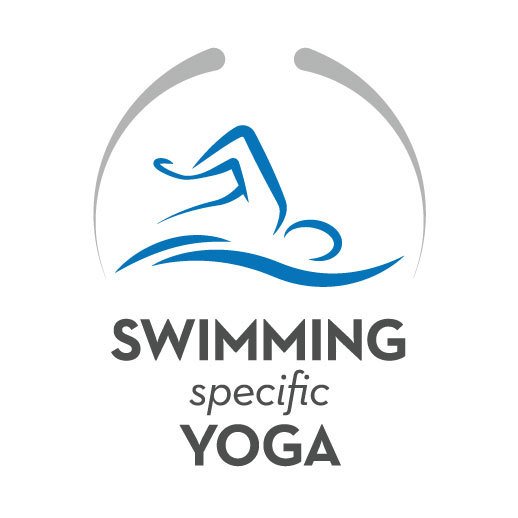
Taper time! Those two magic words are music to the ears of swimmers of all ages across the globe. Incorporating a restorative yoga practice for swimmers into your training can make your taper even more enjoyable and effective than it already is.
After months of hard work, surviving gruelling sets and barely having the energy to get out of bed for morning workouts it is time to refill your fuel tank. Lower volume, easier swims and more time to sleep are all staples of a typical taper.
As training evolves taking a proactive approach to recovery is becoming a more and more important part of preparing for a peak performance. Restorative yoga can help enhance your taper in a few different ways:
- Activates your parasympathetic nervous system
- Gives you a chance to relax and let go
- Allows you the time to work with your breath
- Increases a sense of calm
- Develops self-awareness
- Helps improve sleep
Key Elements of a Restorative Yoga Practice for Swimmers
Restorative yoga can be a challenging practice for swimmers. When you are an active individual being in stillness for longer periods of time is not easy. Remember just because you aren’t moving does not mean you are doing nothing.
The following are a few keys to getting the most out of your restorative yoga practice.
Relax and Let Go, but Stay Present
A restorative yoga practice is a mindful activity. As you move through your practice continue it is important to stay present, which will strengthen your awareness and improve your focus.
Especially in a restorative practice where you are in poses for longer periods of time your attention will wander. The key to practicing in a mindful way is clearing your mind or thinking about nothing it is to notice when your attention is stolen away by thought and to bring your it back to the present moment.
A strategy to do this is to create a home base or anchor for your attention to return back to. A few examples of this are:
- Breathing – the sound, movement and/or feeling of your breath
- A bodily sensation
- Counting your breath – an example of this is to count the inhale as one and exhale as two and so on.
- Noting – an example of this is simply say inhale to yourself on an inhale and exhale on your exhale.
The intent of a restorative practice is create a restful state, because of that it can be hard to stay awake. If you can’t stop yourself from catching some zzzs while in different poses it might mean that you need sleep more than you need restorative yoga.
*Don’t feel bad if you do fall asleep we have all been there – at least I have.
Be Patient
In a restorative practice you hold poses anywhere from 5-20 minutes to give both your body and mind a chance to truly sink into the pose. It will be a challenge if your mind is racing and you feel restless, but commit to the practice and you will feel the benefits.
In her book The Athletes Guide to Recovery Sage Rountree suggest that, “the more restless you are is quite often a sign of how helpful the practice may be.”
Use a Diaphragmatic Breath
Two types of breathing that I love to use in a restorative practice are; a belly breath and a three part breath. As you work with your breath allow your exhales to be longer than your inhales, which helps activate the parasympathetic nervous system, which is responsible for recovery and regeneration.
1. Belly Breath
- Take a few breaths to notice your natural pattern of breath
- If you have not already start to breath in and out through the nose
- You can also breath in through the nose and out slowly through the mouth with pursed lips
- On each inhale breath deeply relaxing your abdomen and allowing the belly expand on each inhale while keeping the chest as still as possible
- With each exhale allow the drop and gently contract
2. Three Part Breath
- The three parts of the breath to focus on are the abdomen, ribs and chest
- Take a few breaths to notice what your natural pattern of breath
- As you build your three part breath exhale the air out through the nose slowly
- Take three breaths where on each inhale breath deeply allowing the belly expanding on each inhale while keeping the ribs and chest as still as possible
- The next three breaths on the inhale feel the belly expand and your ribs widen while keeping the chest as still as possible
- Put together all three parts of the breath on the inhale feel the belly expand, ribs widen and chest rise in a wave like motion or rhythm
Move Through Body Scans at Different Points of Your Practice
Approach this process with a sense of curiosity rather than thinking you should or want to feel a certain way.
At the start of your practice take some time to bring your awareness into the body and move that awareness from either head to toe or toe to head. Notice how each area of your body feels without expecting how you will feel or thinking you should feel a certain way.
This process in itself will help create a relaxation response and give you an opportunity to release tension from the body once you become aware of it.
By repeating this process throughout the practice you start will start to develop greater body awareness and can elicit the relaxation response in different poses releasing different areas of tension.
This process also strengthens your mind-body connection.
https://www.youtube.com/watch?v=vqWYqEuZyBA?feature=oembed&enablejsapi=1&origin=https://swimswam.com
Don’t Search for a Stretch
In a restorative practice you want to allow tension in your body to release and let go thoughts your attention may be attached to. You don’t need to stretch to do that. In fact chasing a release may prevent you from feeling it, allow your self to sink into the poses and the support of the props.
What you need for a restorative yoga practice
- Quiet room
- Props – it will depend on the pose you are doing, but they may include
In a restorative practice you use props to create support in the poses giving your body and mind a signal that you are safe to relax and let go.
Things you can use in place of these:
- Bolster – Watch this video that shows you how simply it is to make a bolster from blankets
- Blocks – In place of blocks you can use books, pull buoys or kick board

- Strap – In place of a strap you can use a belt, band or towel
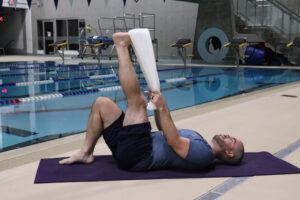
Restorative Yoga Poses for Swimmers
Yoga Poses for Swimmers – Restorative Child’s Pose
Benefits:
- Relaxes the upper body and hips
- Restorative qualities
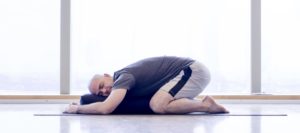
Cues:
- Come onto your knees with the top of your feet down with your big toes together and knees out wide
- Place a bolster in between your knees
- Exhale and fold forward at your hips lying down on the bolster
- Allow your arms to relax to the sides of the bolster
- Allow the upper body and hips to completely relax in this pose
Yoga Poses for Swimmers – Restorative Sphinx
Benefits:
- Spinal mobility
- Restorative qualities
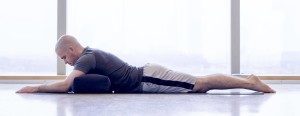
Cues:
- Start lying flat on your stomach with your legs extended behind you
- Place a bolster under you armpits with both arms in front of you resting the forearms on the ground
- Allow for a gently back bend
- Relax your neck
Yoga Poses for Swimmers – Heart Bed
Benefits:
- Opens the front of the body
- Dependent on the position of the legs it can increase hip mobility
- Restorative qualities
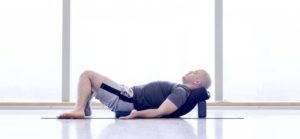
Cues:
- Place a bolster on the ground with a firm block placed under the end where you will lay your head so it is on an incline
- Position a cushion or small yoga block at the opposite end of the bolster
- Sit on the small foam block and lay your back flat on the bolster
- Ensure that your head is resting comfortably on the bolster
- Have the hands at your sides with the palms facing up
- Allow the legs to be in a comfortable position that will allow you to relax
Yoga for Poses for Swimmers – Leg’s Up the Wall
Benefits:
- Benefits lymphatic system
- Lengthens the hamstrings
- Restorative qualities
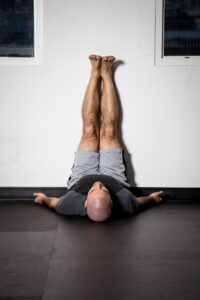
Cues:
- Start sitting down with your legs out in front of you
- Bring your one side of your hips to the wall
- Bend your knees and swivel on your seat bringing your seat towards the wall and your legs up the wall
- Extend the legs towards straight working with your own range
- You should feel a gentle stretch in the hamstrings
- Have the arms at either side of the body with the palms facing straight up to the ceiling
Yoga Poses for Swimmers – Supported Back Bridge
Benefits:
- Spinal, hip and shoulder mobility
- Gentle inversion
- Restorative qualities
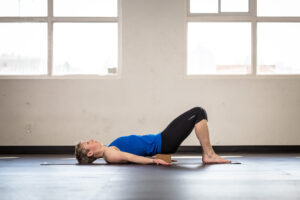
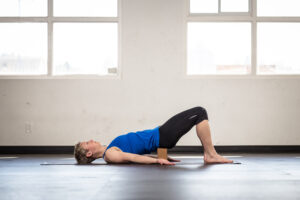
Cues:
- Start flat on your back with the soles of your feet flat on the ground hip distance apart with your arms at your sides
- On an inhale lift your hips off the ground coming into a back bridge
- Place a firm yoga block underneath your sacrum – the flat part of your hips – either on it’s lowest or second lowest height
- Once you feel completely balanced allow your weight to be supported by the block
- Turn your palms up to face the sky
Yoga Poses for Swimmers – Savasana
Benefits:
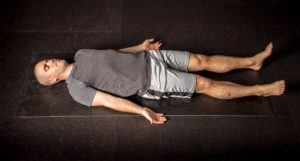
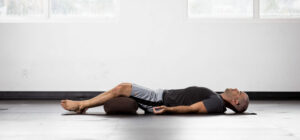
Cues:
- Start lying flat on your back
- Extend your legs long on the ground just past hip distance relaxing the hips possibly allowing the feet to drop out to the side
- Place the arms on either side of the body with the palms facing straight up the to ceiling allowing the chest and shoulders to open and relax
- Have your head heavy on the ground relaxing through the neck and softening the muscles in your face
- Inhale deeply and exhale strongly relaxing through the entire body
…
TO LEARN MORE ABOUT HOW YOGA CAN HELP YOUR SWIMMING PERFORMANCE SIGN UP FOR OUR NEWSLETTER AND JOIN THE SWIMMING-SPECIFIC YOGA COMMUNITY

